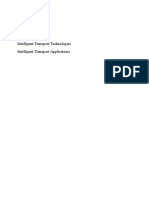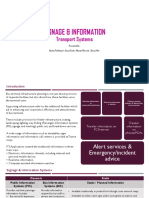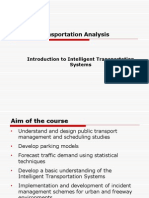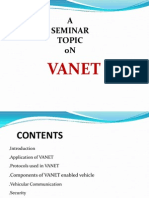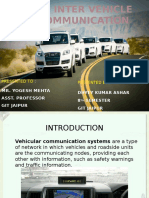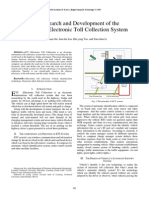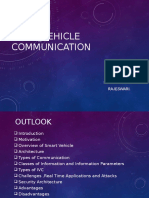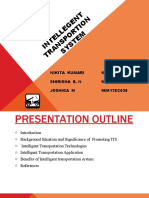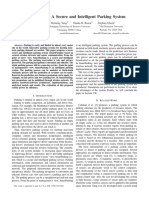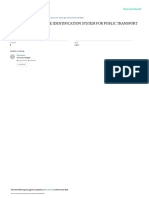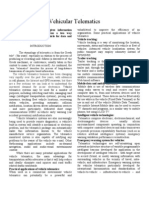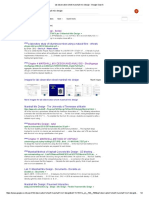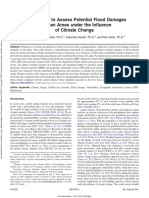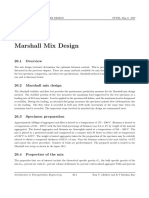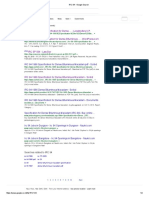Travel Time Data Collection
Travel Time Data Collection
Uploaded by
Shining GardenCopyright:
Available Formats
Travel Time Data Collection
Travel Time Data Collection
Uploaded by
Shining GardenOriginal Description:
Original Title
Copyright
Available Formats
Share this document
Did you find this document useful?
Is this content inappropriate?
Copyright:
Available Formats
Travel Time Data Collection
Travel Time Data Collection
Uploaded by
Shining GardenCopyright:
Available Formats
Transportation Systems Engineering 11.
Travel Time Data Collection
Chapter 11
Travel Time Data Collection
11.1 Introduction
Travel time can be defined as the period of time to transverse a route between any two points
of interest. It is a fundamental measure in transportation. Travel time is also one of the most
readily understood and communicated measure indices used by a wide variety of users, includ-
ing transportation engineers, planners, and consumers. Travel time data is useful for a wide
range of transportation analyses including congestion management, transportation planning,
and traveler information. Congestion management systems commonly use travel time-based
performance measures to evaluate and monitor trac congestion. In addition, some metropoli-
tan areas provide real-time travel time prediction as part of their advanced traveler information
systems (ATIS). Travel time data can be obtained through a number of methods. Some of the
methods involve direct measures of travel times along with test vehicles, license plate match-
ing technique, and ITS probe vehicles. Additionally, various sensors (e.g. inductance loop
detectors, acoustic sensors) in ITS deployment collect a large amount of trac data every day,
especially in metropolitan areas. Such data can be used for travel time estimation for extensive
applications when direct measurements of travel times are not available [19].
Travel time, or the time required to traverse a route between any two points of interest,
is a fundamental measure in transportation. Travel time is a simple concept understood and
communicated by a wide variety of applications for transportation engineers and planners.
Several data collection techniques can be used to collect travel times. These techniques are
designed to collect travel times and average speeds on designated roadway segments or links.
Following are the dierent techniques available for the travel time data collection.
Test Vehicle Techniques
License Plate Matching Techniques
ITS Probe Vehicle Techniques
Dr. Tom V. Mathew, IIT Bombay 11.1 February 19, 2014
Transportation Systems Engineering 11. Travel Time Data Collection
Emerging and Non-Traditional Techniques
11.2 Test Vehicle Techniques
Travel time data using active test vehicles in combination with varying levels of instrumenta-
tion: manual (clipboard and stopwatch), an electronic distance measuring instrument (DMI), or
a global positioning system (GPS) receiver. It involves the use of data collection vehicle within
which an observer records cumulative travel time at predefined checkpoints along a travel route.
Then this information converted to travel time, speed, and delay for each segment along the
survey route. There are several dierent methods for performing this type of data collection,
depending upon the instrumentation used in the vehicle. These vehicles are instrumented and
then sent into the field for travel time data collection, they are sometimes referred to as active
test vehicles [16].
Advantages
Advanced test vehicle techniques (e.g., DMI or GPS use) result in detailed data.
Low initial cost.
Disadvantages
Sources of possible error from either human or electric sources that require adequate
quality control,
Data storage diculties.
11.3 License Plate Matching Techniques
Travel times by matching vehicle license plates between consecutive checkpoints with varying
levels of instrumentation: tape recorders, video cameras, portable computers, or automatic
license plate character recognition [16].
Advantages
Travel times from a large sample of motorists, very simple technique.
Provides a continuum of travel times during the data collection period.
Dr. Tom V. Mathew, IIT Bombay 11.2 February 19, 2014
Transportation Systems Engineering 11. Travel Time Data Collection
Disadvantages
Travel time data limited to locations where observers or video cameras can be positioned;
Limited geographic coverage on a single day
Accuracy of license plate reading is an issue for manual and portable computer
11.4 ITS Probe Vehicle Techniques
Travel times using ITS components and passive probe vehicles in the trac stream equipped
with signpost-based transponders, automatic vehicle identification (AVI) transponders, ground-
based radio navigation, cellular phones, or GPS receivers [16].
Some vehicles are equipped with dynamic route guidance (DRG) device which act as roving
trac detectors, a non-infrastructure based trac monitoring system. Such vehicles, which are
participating in the trac flow and capable of determining experienced trac conditions and
transmitting these to a trac center, are called probe vehicles. To determine its position and
to register experienced trac conditions, a probe vehicle is equipped with on-board electronics,
such as a location and a communication device. By means of the location device, the probe
vehicle keeps track of its own geographic position [16].
Through the communication device, the probe vehicle transmits its trac experiences via a
mobile communication link to a trac center. For instance, each probe can transmit trac
messages once every time interval containing its location and its speed at the instant of trans-
mission. In this trac center the trac data received from probe vehicles is gathered, and
combined with data from the other monitoring sources, and processed into relevant trac in-
formation. It is very useful for Advanced Traveler Information system (ATIS).
Advantages
Low cost per unit of data
Continuous data collection
Automated data collection
Data are in electronic format
No disruption of trac
Dr. Tom V. Mathew, IIT Bombay 11.3 February 19, 2014
Transportation Systems Engineering 11. Travel Time Data Collection
Location Antenna
Signalpost
I.D
Central Computer
Signalpost
Transmitter
Vehicle Location
Unit Radio Signal I.D, Bus I.D,
Antenna Odometer Reading
SignpostBus Communication Link Time/Date Stamp
Radio
Transmitter
BusComputer Center Communication Link
Figure 11:1: Signpost-Based AVL Communication Processes, Source: Travel Time Detection
Hand Book, [16]
Disadvantages
High implementation cost
Fixed infrastructure constraints - Coverage area, including locations of antenna
Requires skilled software
Not recommended for small scale data collection eorts
ITS probe vehicle data collection systems
1. Signpost-Based Automatic Vehicle Location (AVL) - This technique has mostly
been used by transit agencies. Probe vehicles communicate with transmitters mounted
on existing signpost structures shown in Fig. 11:1 [16].
2. Automatic Vehicle Identification (AVI) - Probe vehicles are equipped with electronic
tags. These tags communicate with roadside transceivers to identify unique vehicles shown
in Fig. 11:2 and collect travel times between transceivers [16].
3. Ground-Based Radio Navigation - It is used for transit or commercial fleet manage-
ment, this system is similar to the global positioning system (GPS). Data are collected
by communication between probe vehicles and a radio tower infrastructure as shown in
Fig. 11:3 [16].
Dr. Tom V. Mathew, IIT Bombay 11.4 February 19, 2014
Transportation Systems Engineering 11. Travel Time Data Collection
Central Computer
Toll Plaza, Sign Bridge, Overpass, or Gantry
Tag I.D. #,
Time Stamp Antenna
Date Stamp, Transceiver
Antenna I.D. Reader
Unit AVI tag
Leased Phone Lines #
.D.
Tag I
Reader
Unit
Antenna Spacing
Varies, Typically
Tag I.D. # 25 km
Coaxial Cable,
Radio Wave, or
Microwave
Figure 11:2: AVI Vehicle-to-Roadside Communication Process, Source: Travel Time Detection
Hand Book, [16]
Central Computer
Vehicle Location Vehicle I.D.
Request Time Stamp
Vehicle I.D.
Time Stamp
Vehicle I.D.
Time Stamp
Vehicle I.D.
Time Stamp
GroundBased
Radio Tower
Vehicle Location Unit
Figure 11:3: Ground-Based Radio Navigation Communication Process, Source: Travel Time
Detection Hand Book, [16]
Dr. Tom V. Mathew, IIT Bombay 11.5 February 19, 2014
Transportation Systems Engineering 11. Travel Time Data Collection
11.5 Cellular Geo-location
This experimental technology can collect travel time data by discretely tracking cellular tele-
phone call transmissions. Cellular telephones are also useful to collect travel time data. Two
techniques have been applied using cellular technology: cellular telephone reporting and cellular
geolocating [16].
11.5.1 Cellular Telephone Reporting
An operator at the central control facility records each drivers identification, location, and time,
by monitoring the time between successive telephone calls, travel time or travel speed between
reporting locations are determined. It is useful for assessment of current trac conditions and
for collecting travel time data during delays or accidents. The cellular telephone reporting
method is recommended for short-term studies with low accuracy requirements.
11.5.2 Cellular Geolocation
The cellular geolocating methodology discreetly tracks cellular telephone calls to collect travel
time data and monitor freeway conditions. This technique utilizes an existing cellular telephone
network, vehicle locating devices, and a central control facility to collect travel time data. All
vehicles equipped with cellular telephones are potential probe vehicles. The system automati-
cally detects cellular telephone call initiations and locates the respective probe vehicle within
a few seconds.
Advantages
Driver recruitment not necessary
No in-vehicle equipment to install
Large potential sample
Disadvantages
Low accuracy
Privacy issues
Infrastructure dependent
Dr. Tom V. Mathew, IIT Bombay 11.6 February 19, 2014
Transportation Systems Engineering 11. Travel Time Data Collection
11.6 Emerging and Non-Traditional Techniques
Emerging or non-traditional techniques are based on using point vehicle detection equipment,
such as inductance loop detectors or video cameras. Travel time estimation algorithms have
been developed based upon measurable point parameters such as volume, lane occupancy, or
vehicle headways. Image matching algorithms are used to match vehicle images or signatures
captured at two consecutive observation points. Following are some of the methods used in
emerging techniques [16].
11.6.1 Extrapolation Method
Estimates average travel time by spot speeds, applied for short roadway segments between de-
tection devices. It is more suitable for low accuracy application. The most accurate method to
measure vehicle speed with loop detectors is to place two detectors in series, which is referred to
as speed trap or loop trap. The accuracy of inductance loop speed traps is dependent upon
the trap length, inductance loop wire type, and consistency in design. Many inductance loop
detectors are single loops; primary application is to collect vehicle counts and lane occupancy.
Many research attempts have been made to utilize speed-flow relationships to estimate vehicle
speeds from single loop detectors. The following 11.1 and 11.2 equations have been used to
estimate spot speeds from single loop detectors [16].
volume
Spotspeed = (11.1)
laneoccupancy g
where,
g = speed correction factor (based upon assumed vehicle length, detector configuration, and
trac conditions).
LinkLengthinkm sec
T raveltime = km
3600 (11.2)
Spotspeedin hr hr
11.6.2 Vehicle Signature Matching
Calculates travel time by matching unique vehicle signatures between sequential observation
points. These methods can utilize a number of point detectors such as inductance loop detec-
tors, weigh-in motion sensors, video cameras, and laser scanning detectors. Vehicle signatures
between two consecutive locations to provide a link based travel time and speed. It provides
alternative to ITS probe vehicle based on travel time measurement, in which a probe vehicle is
identified and matched between two locations using a unique identification number.
Dr. Tom V. Mathew, IIT Bombay 11.7 February 19, 2014
Transportation Systems Engineering 11. Travel Time Data Collection
Vehicle signature matching had been investigated using a number of dierent point detection
devices, mostly with inductance loop detectors. Several algorithms are available to capture
vehicle signatures from a loop detector frequency detuning curve. Dierent types and classes of
vehicles provide dierent types of signatures. The unique features of a vehicle signature are then
compared to signatures within a given time frame at a downstream location. The signature is
matched when a large number of feature correlations have been found within vehicle signatures
at the downstream location. The vehicle signature matching technique does not match every
vehicle signature captured, but potentially match a large enough percentage as to be significant
[16].
11.7 Summary
Detailed travel time estimation by dierent techniques has been discussed in this chapter. Also
travel time estimation by vehicle technology and emerging techniques such as vehicle signature
have also been discussed in this chapter.
11.8 References
1. Texas Transportation Institute, Texas A and M University System. Travel Time Data
Collection Handbook,Report FHWA-PL-98-035, 1998.
2. Trac Detector Handbook. Third Edition Volume II, Publication No.FHWA-HRT-06-139
October 2006., 2006.
3. Final Report of Evaluation of Freeway Travel Time Estimates. Castle Rock Consultants
Inc, Portland State University, 2019.
4. Manual on Uniform Trac Control Devices. Federal Highway Administration, U.S.
Department of Transportation, Washington, D.C., 2019.
5. B Coifman. Length based vehicle classification on freeways from single loop Detectors. al
University Transportation Center Final Report, 2009.
6. G C de Silva. Automation of Trac Flow Measurement Using Video Images. Thesis
Report, University of Moratuwa, 2001.
7. S Ding. Freeway Travel Time Estimation using Limited Loop Data. Master Thesis, The
University of Akron, 2008.
Dr. Tom V. Mathew, IIT Bombay 11.8 February 19, 2014
Transportation Systems Engineering 11. Travel Time Data Collection
8. M L Y Elena and L A Klein. Summary of vehicle detection and surveillance technologies
used in intelligent transportation systems. FHWA Report, New Mexico State University
and VDC Project Consultant, 2000.
9. A Faghri and K Hamad. Applications of GPS in Trac Management. 2002.
10. L Guillaume. Road Trac Data: Collection Methods and Applications. JRC Technical
note 47967, 2008.
11. U Leeds. Collection Methods for Additional Data, IMAGINE project no. 503549. Insti-
tute for Transport Studies, University of Leeds, United Kingdom, 2006.
12. P T Martin, Y Feng, and X Wang. Detector Technology Evaluation. Department of Civil
and Environmental Engineering, Utah Trac Lab, 2003.
13. S T Mohammad. Vehicle re-identification Based on Inductance Signature Matching.
Master thesis, University of Toronto, 2011.
14. N Nihan, X Zhang, and Y Wang. Improved System for Collecting Real-Time Truck Data
from Dual Loop Detectors. Transportation Northwest, 2005.
15. S G Ritchie S Park and O Cheol. Field Investigation of Advanced Vehicle Re-identification
Techniques and Detector. California PATH Research Report, 2002.
16. A Parsekar. Blind Deconvolution of Vehicle Inductive Signatures for Travel Time Estima-
tion. Master thesis, Department of Computer Science, University of Minnesota Duluth,
Duluth, Minnesota -55812, 2004.
17. C Ulberg. Vehicle occupancy forecasting, Technical Report. Washington State De-
partment of Transportation Technical, Graduate School of Public Aairs University of
Washington Seattle, Washington 98105, 1994.
18. J Xia and M Chen. Freeway Travel Time Forecasting Under Incident. Final Report,
Southeastern Transportation Center, Department of Civil Engineering, University of Ken-
tucky, Lexington, KY 40506, 2007.
19. B Young and M Saito. Automated Delay Estimation at Signalized Intersections. Research
Division, 2011.
20. Y Zhirui. Speed estimation using single loop detector outputs. Some studies, Ph.D thesis,
Department of CIVIL Engineering, Texas A and M University, 2007.
Dr. Tom V. Mathew, IIT Bombay 11.9 February 19, 2014
You might also like
- Bus Information SystemDocument30 pagesBus Information SystemSir Isaac Wira PratamaNo ratings yet
- Gurgaon Wards ListDocument3 pagesGurgaon Wards ListShining Garden29% (14)
- Assessment Task 1: Research Questions and KnowledgeDocument23 pagesAssessment Task 1: Research Questions and KnowledgeVALENTINA ROJAS VANEGAS100% (2)
- ITS For Traffic ManagementDocument21 pagesITS For Traffic ManagementLauramfsNo ratings yet
- Why Its Intelligent Transport Technologies Intelligent Transport ApplicationsDocument15 pagesWhy Its Intelligent Transport Technologies Intelligent Transport ApplicationsKiran ChathamathNo ratings yet
- Intelligent Transportation System: by Jonathan D'CruzDocument27 pagesIntelligent Transportation System: by Jonathan D'CruzSaahib ReddyNo ratings yet
- Research Article: Smartcop: Enabling Smart Traffic Violations Ticketing in Vehicular Named Data NetworksDocument13 pagesResearch Article: Smartcop: Enabling Smart Traffic Violations Ticketing in Vehicular Named Data NetworksMark Anthony RazonNo ratings yet
- Intelligent Transportation System: Unit-IIDocument78 pagesIntelligent Transportation System: Unit-IIbeka119712No ratings yet
- Automated Traffic Signal For Hassle Free Movement of AmbulanceDocument5 pagesAutomated Traffic Signal For Hassle Free Movement of AmbulanceSimona NicoletaNo ratings yet
- Signages & InformationDocument30 pagesSignages & InformationamulyaNo ratings yet
- Intelligent Transportation SystemDocument11 pagesIntelligent Transportation Systemnavdeep kNo ratings yet
- Intellegent Transportation SystemDocument29 pagesIntellegent Transportation SystemPranvat1711No ratings yet
- 5 Group 9 Traffic Engineering StudiesDocument176 pages5 Group 9 Traffic Engineering StudiesKaye DabuNo ratings yet
- De Gracia Cep412aDocument23 pagesDe Gracia Cep412aDaniella Mae De GraciaNo ratings yet
- An IoT-Based Intelligent System For Real-Time Parking Monitoring and Automatic BillingDocument5 pagesAn IoT-Based Intelligent System For Real-Time Parking Monitoring and Automatic BillingAndrea Dreamin100% (1)
- Iot Based Toll Booth Management System: Aadish Joshi, Gaurav Bhide, Shreyas Patil, R. D. KomatiDocument5 pagesIot Based Toll Booth Management System: Aadish Joshi, Gaurav Bhide, Shreyas Patil, R. D. Komatiakash mishraNo ratings yet
- Intelligent Trasportation SystemDocument28 pagesIntelligent Trasportation SystemRomel VinguaNo ratings yet
- RFID-based Parking Management SystemDocument4 pagesRFID-based Parking Management Systemakashlogic100% (1)
- Signage & Information: Transport SystemsDocument16 pagesSignage & Information: Transport SystemsamulyaNo ratings yet
- Cht13 Cht13 Transportation Demand Ali Transportation Demand Ali Analysis AnalysisDocument43 pagesCht13 Cht13 Transportation Demand Ali Transportation Demand Ali Analysis AnalysisFrancisco GranadosNo ratings yet
- Traffic Signs Localisation and Recognition Using A Client-Server ArchitectureDocument6 pagesTraffic Signs Localisation and Recognition Using A Client-Server ArchitectureMuhammad Rizki RNo ratings yet
- Applied Transportation Analysis - 1Document41 pagesApplied Transportation Analysis - 1RameshbabuNo ratings yet
- Arduino Based Traffic Congestion Control With Automatic Signal Clearance For Emergency Vehicles and Stolen Vehicle DetectionDocument6 pagesArduino Based Traffic Congestion Control With Automatic Signal Clearance For Emergency Vehicles and Stolen Vehicle DetectionBiswajit SantraNo ratings yet
- Automatic Number-Plate RecognitionDocument6 pagesAutomatic Number-Plate RecognitionDivyang PatelNo ratings yet
- 3 Publish Subscribe Notification Middleware For VanetDocument6 pages3 Publish Subscribe Notification Middleware For VanetguezziabdelkaderNo ratings yet
- 1Document8 pages1Saravanan PalaniNo ratings yet
- Vanetppt 180125080458Document29 pagesVanetppt 180125080458Assad LeoNo ratings yet
- VANETDocument21 pagesVANETArunNo ratings yet
- Ters 3Document7 pagesTers 3Parthiv TrivediNo ratings yet
- 3.4 AITD - Mr. D P GuptaDocument21 pages3.4 AITD - Mr. D P GuptaErwin SaputraNo ratings yet
- (Q2) IoT Based Sensor Enabled Vehicle Parking SystemDocument6 pages(Q2) IoT Based Sensor Enabled Vehicle Parking SystemMuhammad ZamryNo ratings yet
- Smart Cars: Evolution To RevolutionDocument55 pagesSmart Cars: Evolution To RevolutionPrashant SharmaNo ratings yet
- Intelligent Transportation Systems and CommunicationsDocument13 pagesIntelligent Transportation Systems and Communicationsbal_kishanNo ratings yet
- QR CodeDocument7 pagesQR CodeSen PaiiNo ratings yet
- Processes 09 01786 v2Document19 pagesProcesses 09 01786 v2Amul ShresthaNo ratings yet
- Its 2Document37 pagesIts 2NM2104TE06 PRATHURI SUMANTHNo ratings yet
- Research On Intelligent Transportation System Technologies and ApplicationsDocument3 pagesResearch On Intelligent Transportation System Technologies and ApplicationsArchana Raj100% (1)
- Inter Vehicle CommunicationDocument23 pagesInter Vehicle Communicationashar dhyeyNo ratings yet
- Traffic ControlDocument4 pagesTraffic ControlShreemay BhuyanNo ratings yet
- Makale 1Document4 pagesMakale 1Hayriye Nur CömertoğluNo ratings yet
- The Research and Development of The Highway's Electronic Toll Collection SystemDocument5 pagesThe Research and Development of The Highway's Electronic Toll Collection SystemprashanthreddyNo ratings yet
- EasyChair-Preprint-10476Document6 pagesEasyChair-Preprint-10476MaruthiNo ratings yet
- ITS Applications: Advanced Traffic Management System (Atsm) Advanced Traveller Information System (Atis)Document14 pagesITS Applications: Advanced Traffic Management System (Atsm) Advanced Traveller Information System (Atis)SYifa ShuhaIliNo ratings yet
- 1815-Article Text-3402-1-10-20210408Document10 pages1815-Article Text-3402-1-10-20210408christianpaulmontebon974No ratings yet
- A Smart Bus Tracking System Based On Location-Aware Services and QR Codes 4Document5 pagesA Smart Bus Tracking System Based On Location-Aware Services and QR Codes 4Amanuel SeidNo ratings yet
- Inter Vehicle Communication Seminar PresentationDocument41 pagesInter Vehicle Communication Seminar PresentationMahaManthra40% (5)
- Intelligent Transportation SystemDocument11 pagesIntelligent Transportation SystemCollins omondi onyangoNo ratings yet
- Intelligent Transport SystemDocument26 pagesIntelligent Transport SystemchinchuNo ratings yet
- Design of Intelligent Ambulance and Traffic Control: Sarika B. Kale, Gajanan P. DhokDocument4 pagesDesign of Intelligent Ambulance and Traffic Control: Sarika B. Kale, Gajanan P. Dhokpalanibhargavi22No ratings yet
- IRJMETS384009-Fleet ManagementDocument7 pagesIRJMETS384009-Fleet ManagementAnupama JawaleNo ratings yet
- Intelligent Transportation SystemDocument21 pagesIntelligent Transportation SystemSumanth BsNo ratings yet
- An IOT System For Smart ParkingDocument19 pagesAn IOT System For Smart Parkingzytech028No ratings yet
- MINI PROJECT REPORT ON SIMULATION OF IoT BASED ELECTRONIC TOLL COLLECTION (ETC) SYSTEM USING RFIDDocument13 pagesMINI PROJECT REPORT ON SIMULATION OF IoT BASED ELECTRONIC TOLL COLLECTION (ETC) SYSTEM USING RFID19DC03 BALAGANESH ANo ratings yet
- Ad Hoc Networks: Hyeong-Jun Chang, Gwi-Tae ParkDocument10 pagesAd Hoc Networks: Hyeong-Jun Chang, Gwi-Tae ParkMOHAMMAD ABU KHALIFANo ratings yet
- Gauging The Performance of Re-Routing in VANET Using MomentsDocument6 pagesGauging The Performance of Re-Routing in VANET Using MomentsIOSRjournalNo ratings yet
- Intellegent Transportion SystemDocument26 pagesIntellegent Transportion Systemnikita kumariNo ratings yet
- SmartParking A Secure and Intelligent Parking SystemDocument11 pagesSmartParking A Secure and Intelligent Parking SystemFabián CNo ratings yet
- Jelusic Isep 2014 FinalpDocument8 pagesJelusic Isep 2014 FinalpSimona NicoletaNo ratings yet
- Electronic Toll CollectionDocument37 pagesElectronic Toll CollectionFazil Puthiyottil100% (1)
- Vehicular Telematics1Document2 pagesVehicular Telematics1Vivek Vardhan BitraNo ratings yet
- IoT Enabled Smart Traffic SystemDocument17 pagesIoT Enabled Smart Traffic Systemk.goyal5095No ratings yet
- Automatic Number Plate Recognition: Unlocking the Potential of Computer Vision TechnologyFrom EverandAutomatic Number Plate Recognition: Unlocking the Potential of Computer Vision TechnologyNo ratings yet
- Large Amplitude Oscillatory Shear of Pseudoplastic and Elastoviscoplastic MaterialsDocument47 pagesLarge Amplitude Oscillatory Shear of Pseudoplastic and Elastoviscoplastic MaterialsShining GardenNo ratings yet
- Toll OperationsDocument12 pagesToll OperationsShining GardenNo ratings yet
- Lab Observation Sheet Marshall Mix Design - Google SearchDocument1 pageLab Observation Sheet Marshall Mix Design - Google SearchShining GardenNo ratings yet
- Methodology To Assess Potential Flood Damages in Urban Areas Under The Influence of Climate ChangeDocument13 pagesMethodology To Assess Potential Flood Damages in Urban Areas Under The Influence of Climate ChangeShining GardenNo ratings yet
- BIO 101: Assignment #1: Jones 10:30amDocument5 pagesBIO 101: Assignment #1: Jones 10:30amShining GardenNo ratings yet
- Lec 26Document1 pageLec 26Shining GardenNo ratings yet
- 28 IRC 94 1986 Specification For Dense ... Localbodies U.PDocument2 pages28 IRC 94 1986 Specification For Dense ... Localbodies U.PShining GardenNo ratings yet
- On Foot Bicycle Moped/Scooter/Motor Cycle Car/Jeep/Van Tempo/Autorickshaw/Taxi Bus Train Water Transport Any Other No Travel All ModesDocument1 pageOn Foot Bicycle Moped/Scooter/Motor Cycle Car/Jeep/Van Tempo/Autorickshaw/Taxi Bus Train Water Transport Any Other No Travel All ModesShining GardenNo ratings yet
- Urgent Notice For Attention of All Students of The InstituteDocument1 pageUrgent Notice For Attention of All Students of The InstituteShining GardenNo ratings yet
- National Institute of Technology Srinagar, Hazratbal Srinagar KashmirDocument7 pagesNational Institute of Technology Srinagar, Hazratbal Srinagar KashmirShining GardenNo ratings yet
- HKUST UG Course CatalogDocument8 pagesHKUST UG Course CatalogShining GardenNo ratings yet
- NPTEL Links CEDocument1 pageNPTEL Links CEShining GardenNo ratings yet
- Tle Notes (Lecture)Document6 pagesTle Notes (Lecture)Orlan Adriyel CodamosNo ratings yet
- 3D Recording, Documentation and Management of Cultural Heritage - Remondino Stylianidis (Eds.) (2016)Document417 pages3D Recording, Documentation and Management of Cultural Heritage - Remondino Stylianidis (Eds.) (2016)Lígia TriquesNo ratings yet
- DLP English Q4 Week1 - D1Document4 pagesDLP English Q4 Week1 - D1RachelNo ratings yet
- G.O No 401-JK (HME) of 2023 Dated 12.05.2023 Appointment-Postings of Medical Officers - Operation of Waiting List, ThereofDocument6 pagesG.O No 401-JK (HME) of 2023 Dated 12.05.2023 Appointment-Postings of Medical Officers - Operation of Waiting List, Thereofbhatarsalan432No ratings yet
- Worksheet PRISM and PYRAMIDDocument3 pagesWorksheet PRISM and PYRAMIDNanang NurdinNo ratings yet
- Deepwater Training Seminar Presented ToDocument36 pagesDeepwater Training Seminar Presented ToSergio Jesus MarquezNo ratings yet
- Soal Ulangan Harian Bahasa Inggris Kelas 9Document14 pagesSoal Ulangan Harian Bahasa Inggris Kelas 9de rantiNo ratings yet
- 21st Century Storage Acquires New Property in New YorkDocument2 pages21st Century Storage Acquires New Property in New YorkPR.comNo ratings yet
- Estrada V Desierto DigestDocument2 pagesEstrada V Desierto DigestKacel Castro100% (9)
- 11me201 Thermodynamics QuestionsDocument12 pages11me201 Thermodynamics QuestionsramsastryNo ratings yet
- Ultima Sales Presentation 4-26-19Document60 pagesUltima Sales Presentation 4-26-19simon tabordaNo ratings yet
- Security Catalogue ExDocument92 pagesSecurity Catalogue ExEmil VasilevNo ratings yet
- DisciplinesDocument43 pagesDisciplinesKevin Russell50% (2)
- Curriculum Map Health Grade - 7Document6 pagesCurriculum Map Health Grade - 7Shiela Mea BlancheNo ratings yet
- The Evidence That It Is Obligatory To Offer Prayers in Congregation in The MosqueDocument9 pagesThe Evidence That It Is Obligatory To Offer Prayers in Congregation in The MosqueShahzaib ParvaizNo ratings yet
- Unit LPDocument22 pagesUnit LPapi-539621421No ratings yet
- 12 Chapter2 PDFDocument22 pages12 Chapter2 PDFSimr singhNo ratings yet
- Action Plan RemedialDocument1 pageAction Plan RemedialRonnie TambalNo ratings yet
- SQL FinalDocument76 pagesSQL FinalSachinNo ratings yet
- Letras de Taylor Swift You'Re On Your Own, Kid - Buscar Con GoogleDocument1 pageLetras de Taylor Swift You'Re On Your Own, Kid - Buscar Con GoogleSophia JNo ratings yet
- Unconfined Compression TestDocument3 pagesUnconfined Compression TestThrisha SoquitosoNo ratings yet
- Small Scale Industries (Ssi) - ShortDocument22 pagesSmall Scale Industries (Ssi) - ShortAadil KakarNo ratings yet
- Sample Interview TranscriptDocument4 pagesSample Interview TranscriptWahib LahnitiNo ratings yet
- International Safety Rating: (PART 1)Document17 pagesInternational Safety Rating: (PART 1)Faisal FahdNo ratings yet
- Impulsive Buying Behavior of Restaurant Products in Social Commerce: A Role of Serendipity and Scarcity MessageDocument16 pagesImpulsive Buying Behavior of Restaurant Products in Social Commerce: A Role of Serendipity and Scarcity MessageDivya Darshini SaravananNo ratings yet
- L04 Qualitative Risk Analysis PDFDocument14 pagesL04 Qualitative Risk Analysis PDFkatherineNo ratings yet
- Gerçek Hayatta 456.000 Dolarlık Squid GameDocument21 pagesGerçek Hayatta 456.000 Dolarlık Squid Gamekifayetulfet27No ratings yet
- Smart Ink PenDocument22 pagesSmart Ink PenVinay kcNo ratings yet
- Regenerative Braking System Group 7Document12 pagesRegenerative Braking System Group 7A-16 Sanket GhadageNo ratings yet




